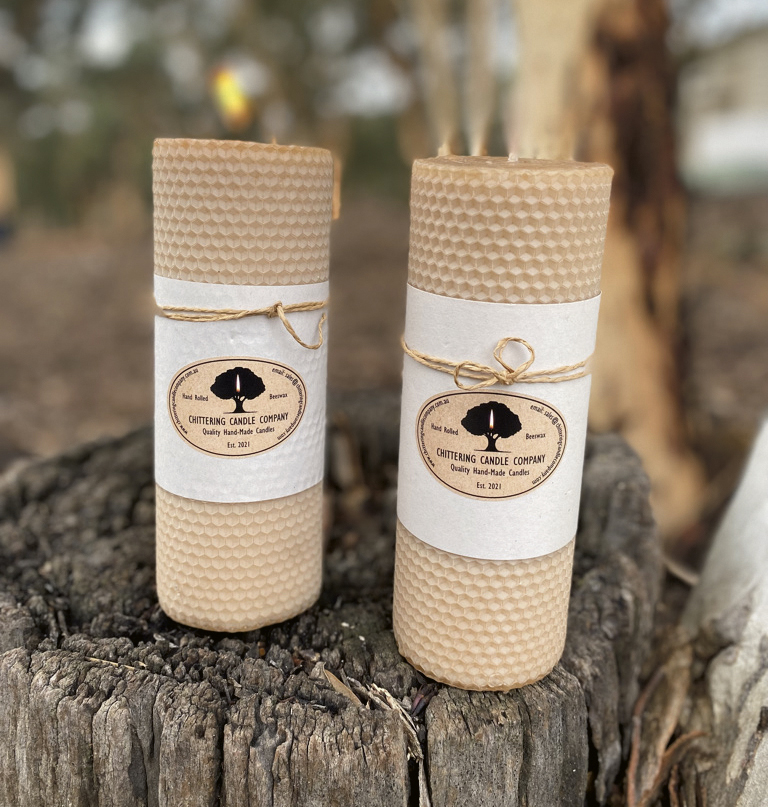
Meet our Chittering chandler
Just when you thought we had just about everything in Chittering, a genuine candlestick-maker has jumped in the tub – joining the local butcher and baker and elevating the shire’s assets to true rub-a-dub status!
Rod Mullineux certainly never set out to become a candlemaker – or relive a centuries-old nursery rhyme – but the mining engineer couldn’t go past the challenge when he discovered common candles not only contain synthetics and petrochemicals, but are more often than not are manufactured unsustainably – usually in China.
Rod was building some cabinetry for Urban Revolution in Victoria Park, when the owner mentioned how difficult it was to source pure beeswax candles, without chemicals or other nasties. With an already established interest in living a more sustainable, low impact lifestyle, the idea ignited Rod’s curiosity and with the help of YouTube, he embarked on learning the art of candle making. “I never realised it was so technical,” says Rod. “I thought a wick was just a wick!”
As turns out, neither candles nor wicks are created equal – far from it in fact.
“My research led me to a fully sustainable wick maker in South Australia. You see most wicks are laced with synthetics to help them burn, and those plastics are released into the air,” explains Rod. “The wicks I use are made with 100% cotton and are also square in shape. They draw really well.”
His mission to use locally-made ingredients led Rod to a Fremantle-based company to source his beeswax. “The guy who runs it is really passionate and he only uses WA beeswax with no pesticides or chemicals – it’s some of the purest beeswax in the world. He uses a specialised machine which presses the wax into sheets which makes them easier to work with.”
“We didn’t want to use soy, because of the negative impact growing soybeans has on the environment,” he says.
Although soy is a natural, renewable product, and soy candles are light in chemical additives (preferable to paraffin wax), soybean cultivation is responsible for massive deforestation and displacement of Indigenous populations in places like Argentina and Brazil, where soybean production operates on an industrial scale. In contrast, beeswax has a very small environmental impact – not to mention its delicious by-product!
While Rod’s wife Lina helps with sales and marketing of their sustainable side hustle, she is quick to confirm the candle quest was all Rod’s idea – and it’s his skills and attention to detail that make Chittering Candles so special.

Each candle is hand-rolled by Rod, and although he describes them as rustic, they are as meticulously made as they are researched and it’s hard to believe they are not machine-hewn. “They don’t look like that if I roll them!” says Lina.
Lina loves burning the beautiful candles in the house – especially for yoga and meditation. “The beauty of a beeswax candle is a clean burn – it’s purifying and antibacterial,” she explains. “They also smell great as they are naturally scented by the honey and floral nectar from within the honeycomb itself.”
It was the clean burning of beeswax candles that saw them used as far back as the Middle Ages, when they were the illumination of choice in churches and wealthy homes. They were preferable to the smoky, smelly tallow or animal fat-based candles commonly made and sold door-to-door by candlemakers, or chandlers (yes friends – that’s where that name comes from!).
Beeswax was hard to come by then, and beeswax candles were reserved for the lucky few who could afford them. The majority of candles were still made with animal fats until the 1850’s, when chemists learned how to efficiently separate the naturally-occurring waxy substance from petroleum and refine it into the paraffin wax we know today. Petroleum-based wax (made mainly in China) now forms the majority of standard manufactured candles on the market, along with vegetable-based soy wax made from the oil of soybeans (grown primarily in North and South America) – a softer and slower burning wax which, unlike paraffin, is renewable, but with its own set of environmental drawbacks already mentioned.
For Rod and Lina (an environmental scientist), beeswax candle making fits well with their journey to live a low-impact life on their pretty 5-acre block in Chittering. Here they are also researching ways to return their parcel of former farmland to its natural bush state, by improving the soil and water retention as well as planting and protecting the endemic species.
“We are an environmentally conscious company aimed at minimising our environmental footprint where ever possible. Our candles and packaging are compostable, leaving no trace when they return to the soil at the end of their life,” explains Lina.
Their passion to create a genuinely sustainable and uniquely Chittering product is still burning brightly, and plans to expand the business continue, with scented and citronella candles on the horizon. For now, their hand-crafted candles are available from selected shops, including the Northern Valleys Locavore Store


